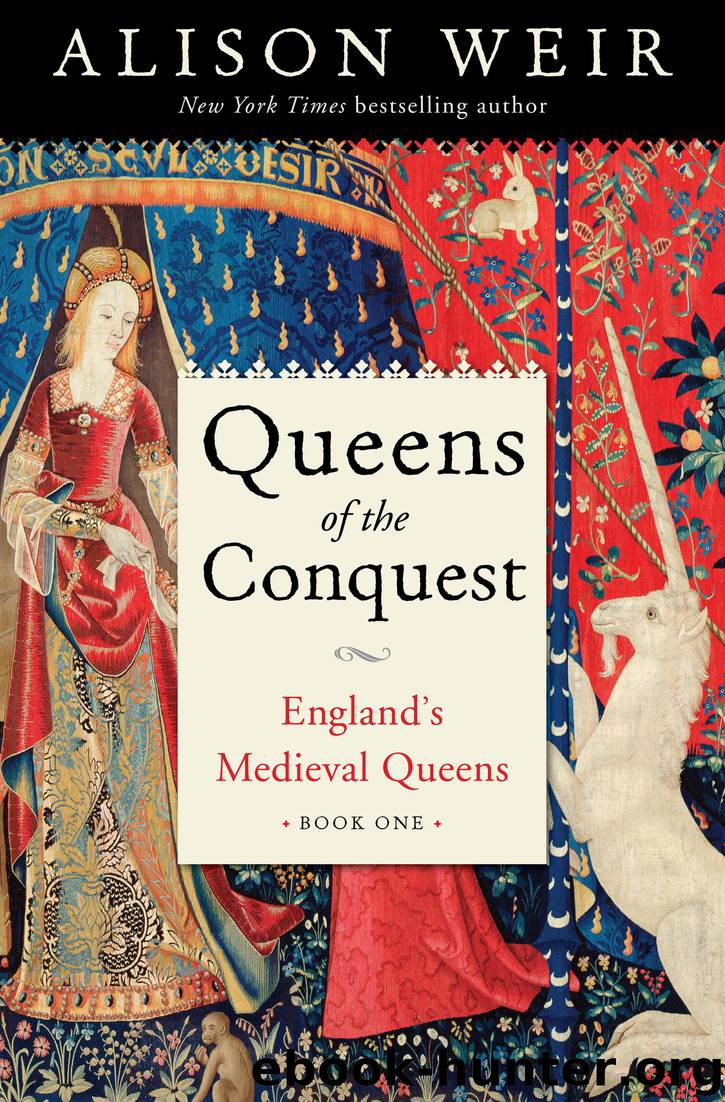Queens of the Conquest by Alison Weir

Author:Alison Weir
Language: eng
Format: epub
Publisher: Random House Publishing Group
Published: 2017-09-26T04:00:00+00:00
1
“In Violation of His Oath”
In the twelfth-century church of St. Peter at Tickencote, Rutland, a pair of stone crowned Janus heads on the Norman chancel arch turn disdainfully away from each other. They are said to represent Stephen and Maud, and as such encapsulate the conflict to come. For Henry I’s death left England open to civil war.
Stephen, probably believing what Bigod had told him, and perhaps having sounded out various barons in recent years,1 acted with unusual decisiveness and impressive speed. Disregarding the oath of fealty he had sworn to the Empress, and taking advantage of the absence of the barons mourning the late King, he left his pregnant wife Matilda in Boulogne and raced across the English Channel, resolved to seize the crown. Dover, guarded by Earl Robert’s soldiers, would not admit him, but he managed to land elsewhere in Kent. The exact date is not recorded, but on that very morning, there was “a terrible peal of thunder, with most dreadful lightning, so that the world seemed well-nigh about to be dissolved,”2 which some saw as ill omened.
Stephen rode like the wind for the capital, Winchester. He may well have laid contingency plans for his accession with his younger brother, Henry of Blois,3 an ambitious man whose rise had been meteoric thanks to Henry I’s patronage. Henry of Blois had been twenty-eight when his uncle summoned him from Cluny in Burgundy to become abbot of Glastonbury; he had been appointed bishop of Winchester at thirty-one, and was now the richest clergyman in the kingdom. He was a strong-minded, energetic and ambitious man, “crafty and inordinately fond of money,”4 in a very different mold from his brother, but staunch in his support of Stephen from the first, and he readily opened up the royal treasury at Winchester, giving him the wherewithal to bribe those who had not yet declared for him.
Thus enriched, Stephen hastened on to London, at this time a city of between fifteen thousand and thirty thousand inhabitants. Here he won enthusiastic support by declaring it a self-governing commune with the power to raise the taxes it needed. The London merchants were also pleased that Channel trade would be protected and tariffs kept low, thanks to Stephen’s control of shipping from Boulogne.
Stephen’s promise to uphold the liberties of the Church secured for him the support of the Justiciar, Bishop Roger of Salisbury. Archbishop William de Corbeil, who had initially declared that the oath to Maud could not be broken, was also won over, especially by Hugh Bigod’s testimony. The Archbishop had been the first to swear fealty to the Empress, which moved Henry of Huntingdon—who had been firmly in Bishop Roger’s camp and therefore hostile to Maud5—to comment that there was “nothing to praise” in him. The Archbishop’s acceptance more or less guaranteed that the rest of the clergy would follow his example. Thus bolstered, Stephen “snatched the crown in violation of his oath,” “shamelessly tempting God”6—and unopposed by Maud or her adherents.
Modern historians might not
Download
This site does not store any files on its server. We only index and link to content provided by other sites. Please contact the content providers to delete copyright contents if any and email us, we'll remove relevant links or contents immediately.
| Africa | Americas |
| Arctic & Antarctica | Asia |
| Australia & Oceania | Europe |
| Middle East | Russia |
| United States | World |
| Ancient Civilizations | Military |
| Historical Study & Educational Resources |
Room 212 by Kate Stewart(4989)
The Crown by Robert Lacey(4703)
Endurance: Shackleton's Incredible Voyage by Alfred Lansing(4648)
The Iron Duke by The Iron Duke(4266)
The Rape of Nanking by Iris Chang(4117)
Joan of Arc by Mary Gordon(3998)
Killing England by Bill O'Reilly(3936)
Say Nothing by Patrick Radden Keefe(3864)
I'll Give You the Sun by Jandy Nelson(3338)
Shadow of Night by Deborah Harkness(3272)
Hitler's Monsters by Eric Kurlander(3252)
Mary, Queen of Scots, and the Murder of Lord Darnley by Alison Weir(3128)
Blood and Sand by Alex Von Tunzelmann(3112)
Darkest Hour by Anthony McCarten(3052)
Eleanor & Park by Rainbow Rowell(3025)
Margaret Thatcher: The Autobiography by Thatcher Margaret(3016)
Red Famine: Stalin's War on Ukraine by Anne Applebaum(2854)
Book of Life by Deborah Harkness(2847)
The One Memory of Flora Banks by Emily Barr(2767)
